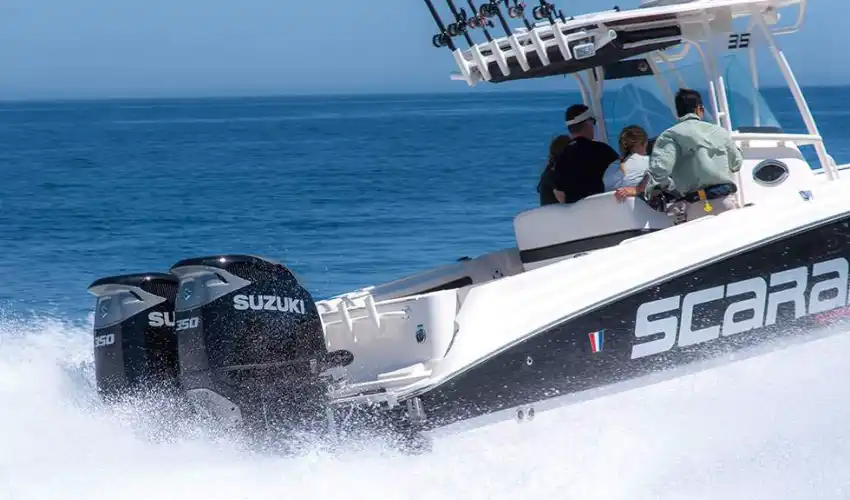If you’re new to boating or just exploring marine engines, you may be wondering, “What is an outboard motor and how does it work?” Outboard motors are essential to many watercraft and are popular due to their convenience, efficiency, and versatility. In this article, we’ll break down everything you need to know about outboard motors—from their basic function to how they power your boat.
What Is an Outboard Motor?
An outboard motor is a self-contained engine system mounted on the outside of a boat, typically at the stern (rear). It combines an engine, gearbox, and propeller in one portable unit. This setup makes it easy to install, remove, and maintain, which is why outboards are commonly used for small to medium-sized boats.
Unlike inboard motors, which are located inside the boat’s hull, outboard motors for sale hang off the transom. This external mounting allows for better space utilization inside the boat and easier steering control.
Components of an Outboard Motor
An outboard motor consists of several key components:
- Engine: This is the power source, which can be a two-stroke or four-stroke internal combustion engine.
- Gearcase: Also known as the lower unit, it houses gears that transfer power from the engine to the propeller.
- Propeller: The rotating blade that pushes the boat through the water.
- Midsection: Connects the powerhead to the lower unit and includes the drive shaft.
- Mounting Bracket: Secures the motor to the boat and often includes a swivel for steering.
- Tiller or Remote Controls: Used to steer and control throttle and gear shift.
How Does an Outboard Motor Work?
An outboard motor works similarly to a car engine but is adapted for marine use. Here’s a step-by-step overview of how it powers a boat:
- Ignition and Fuel Combustion
When you start the motor, either manually with a pull cord or electronically, the ignition system sparks a mixture of fuel and air inside the engine cylinder. This combustion creates pressure that pushes the pistons down.
- Power Transmission
The movement of the pistons turns the crankshaft. The crankshaft’s rotational motion is transferred down through the drive shaft to the gearcase.
- Gear Engagement
Inside the gearcase, gears adjust the direction of the power to turn the propeller. You can shift into forward, neutral, or reverse, depending on how you control the motor.
- Propeller Motion
As the propeller spins, it displaces water and propels the boat forward or backward. Steering is done by rotating the entire outboard motor, which changes the direction of the thrust.
Two-Stroke vs. Four-Stroke Outboard Motors
Outboard motors come in two main types: two-stroke and four-stroke.
- Two-Stroke Engines: These are generally lighter and offer faster acceleration. They require a mixture of oil and gasoline.
- Four-Stroke Engines: These are quieter, more fuel-efficient, and emit fewer emissions. They run on straight gasoline and have a separate oil reservoir.
Modern four-stroke motors are popular due to environmental regulations and efficiency, although two-strokes still have a loyal following among performance enthusiasts.
Electric Outboard Motors
Electric outboard motors are gaining popularity as eco-friendly alternatives. They are powered by rechargeable batteries and produce no emissions or noise. Ideal for small boats or lakes with restrictions on gas engines, electric outboards are easy to operate and maintain.
Advantages of Outboard Motors
Outboard motors offer several benefits:
- Easy Maintenance: Being mounted outside, they are simple to access and service.
- Portability: Smaller models can be easily removed for storage or security.
- Steering Control: They offer responsive handling, especially at low speeds.
- Space Efficiency: No engine compartment means more room inside the boat.
Common Uses of Outboard Motors
Outboard motors are widely used for:
- Fishing boats
- Pontoon boats
- Inflatable boats
- Rescue and patrol boats
- Recreational and sports boating
They are ideal for both freshwater and saltwater use, although maintenance requirements may vary based on the environment.
Maintenance Tips for Outboard Motors
Proper care ensures long-lasting performance:
- Flush the engine after saltwater use.
- Check and change the engine oil regularly.
- Inspect the propeller for damage or debris.
- Replace the fuel filter and spark plugs as needed.
- Store the motor properly in off-season months.
Final Thoughts
Understanding what an outboard motor is and how it works can enhance your boating experience and help you make informed decisions when purchasing or maintaining one. Whether you’re navigating calm lakes or venturing into open waters, a reliable outboard motor is your key to smooth and powerful propulsion.
If you’re looking for mobility, power, and ease of use on the water, an outboard motor is a smart investment for any boat owner.
